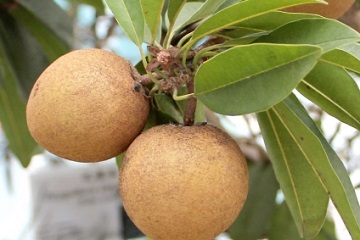Antibacterial Activity of bark of Manilkara zapota

Antibiotic resistance is rising to dangerously high levels in all parts of the world. New resistance mechanisms are emerging and spreading globally, threatening our ability to treat common infectious diseases. A bacterial resistance to most antibiotics is on the rise and some new types of infections are increasingly in need of serious treatment. Alternative antibacterial drugs are increasingly needed. Sawo Manila (Manilkara zapota) is a genus of trees in the family Sapotaceae, widespread in the Old and New World tropis and subtropics. The generic name derives from 'manil-kara', a vernacular name in the Malayalam language of south India for Manilkara kauki, the type species for the genus. is a plant with roots, flowers, leaves and bark of the stem has been tested to have activity as an antibacterial. There is a group of compounds from these plants in addition to triterpenoids that may have unreported antibacterial activity.
A group of researchers of Bogor Agricultural Universoty (IPB) implemented the research program to investigate the antioxidant and antimicrobial properties from different solvent extracts of leaves of M. zapota obtained the antibacterial activity of methanol fraction rich in quercetin from bark of Manilkara zapota. The group were Swira Ekalina, Purwatiningsih Sugita, and Irma Herwati Suparto, of the Department of Chemistry, Faculty of Mathematics and Natural Sciences of Bogor Agricultural Universoty (FMIPA IPB).
Purwatiningsih said, sawo manila is a plant rich in biological activity, one of them as antimicrobial. " Plants are a rich source of pharmacologically active molecules that have been used for native people to treat several diseases. Plants of the genus Manilkara are potential sources of antibacterial and anticancer secondary metabolites. They are very effective as an antibacterial for various species of gram positive and negative bacteria. Nevertheless, the studies are limited to the crude extract alone, "she said.
She explained that as many as 13 triterpenoid compounds have been isolated from bark of M. zapota. Six (6) triterpenoid tracerasana, compounds and (7) seven triterpenoid lupane compounds were isolated. Testing of antibacterial activity of those 13 compounds against B. subtilis, S. aureus and E. coli have minimum inhibitory concentration value that is> 1 mg / mL.
She added that a number of studies on Manila sapwood plant extracts showed that M. zapota leaves extracts are highly potential as antibacterial agents. Nevertheless, no studies have been reported on the group of compounds other than triterpenoids as antibacterial agents of M. zapota. Research on M. zapota as antibacterial in Indonesia is limited to the crude extract of fruit and bark. Extracts prepared from seeds of Manilkara zapota, Anona squamosa, and Tamarindus indica were screened for their antibacterial activity by disc diffusion and broth dilution methods. Acetone and methanol extracts of T. indica seeds were found active against both gram-positive and gram-negative organisms. MIC values of potent extracts against susceptible organisms ranged from 53-380 μg/mL. Methanol extract of T. indica and acetone extract of M. zapota seeds were found to be bactericidal. The acetone extract of M. zapota leaves possess strong antioxidant and antimicrobial properties, and it may be considered as an interesting and economic source of antioxidants and antimicrobics for therapeutic or nutraceutical industries and for food manufactures or pharmaceuticals.
"However, research to investigate the potential antibacterial activity of bark M. zapota has never been done in Indonesia, including in West Nusa Tenggara. Being a cultivated fruit crop, numerous cultivars exist, often bearing local names; in many cases names in different localities are presumably synonyms. In Indonesia, two groups of cultivars are distinguished: (i) the Sawo manila type with ovoid fruit, including Sawo Betawi and Sawo Kulan; and (ii) the Sawo apel type with globose fruits, e.g. Sawo Apel Benar and Sawo Apel Lilin. Though this plant is relatively easy to find in the area, "she said.
The results of the composition of the tannin-free methanol fraction compound from selected bark of M. zapota (methanol) has mass spectroscopic chromatograms with an abundance of close to 100% at Rt 16.83 min. The compound is thought to be 3 ', 4', 5.7-tetramethyl quercetin is the most important antibacterial compound of bark of M. zapota. (Wied)



